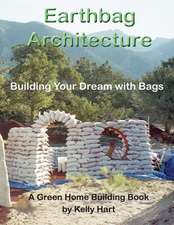Developments in Structural Form
Autor Rowland Mainstoneen Limba Engleză Paperback – 17 sep 2001
In this extensively revised and expanded new edition, now available in paperback, new insights and a full coverage of recent developments in both design and construction are incorporated. The book identifies features that distinguish the forms built by man from those shaped by nature and discusses the physical and other constraints on the choices that can be made. It then looks in turn at all the elementary forms - arches, domes, beams, slabs and the like - which combine into the more complex forms of complete structures, and at the different classes of the complete forms themselves. The development of each form is traced chronologically, but with an emphasis less on the chronology than on the problems that designers have continually faced in trying to serve new ends with limited means or to serve old ones in new ways. The book concludes with a chapter on the processes of design, showing how the designer's freedom of choice has been widened by a growing understanding of structural behaviour.
| Toate formatele și edițiile | Preț | Express |
|---|---|---|
| Paperback (1) | 404.83 lei 5-7 săpt. | |
| Taylor & Francis – 17 sep 2001 | 404.83 lei 5-7 săpt. | |
| Hardback (1) | 764.20 lei 6-8 săpt. | |
| Taylor & Francis – 24 apr 2016 | 764.20 lei 6-8 săpt. |
Preț: 404.83 lei
Preț vechi: 747.90 lei
-46% Nou
Puncte Express: 607
Preț estimativ în valută:
77.46€ • 80.88$ • 64.11£
77.46€ • 80.88$ • 64.11£
Carte tipărită la comandă
Livrare economică 28 martie-11 aprilie
Preluare comenzi: 021 569.72.76
Specificații
ISBN-13: 9780750654517
ISBN-10: 0750654511
Pagini: 382
Ilustrații: 270 b&w photographs, 90 line illustrations
Dimensiuni: 210 x 297 x 22 mm
Greutate: 1.11 kg
Ediția:2 Rev ed.
Editura: Taylor & Francis
Colecția Routledge
Locul publicării:Oxford, United Kingdom
ISBN-10: 0750654511
Pagini: 382
Ilustrații: 270 b&w photographs, 90 line illustrations
Dimensiuni: 210 x 297 x 22 mm
Greutate: 1.11 kg
Ediția:2 Rev ed.
Editura: Taylor & Francis
Colecția Routledge
Locul publicării:Oxford, United Kingdom
Public țintă
Professional Practice & DevelopmentCuprins
Preface; Part 1: Introductory: Introduction; Structural actions and materials; Construction and form; Structure and form; Part 2: Structural elements: Arches, vaults, domes, curved membranes, beams and slabs, trusses, portal frames, space frames, supports, walls, foundations; Part 3: Complete structures: Early forms; Pre-nineteenth-century wide-span buildings; Nineteenth-and twentieth-century wide-span buildings; Bridges; Multi-storey buildings and towers; Part 4: Design: Structural understanding and design.
Recenzii
'This is a remarkable book, conceived in an original way and one which, so far as I know, has not previously been attempted.'
Sir John Summerson.
'This book should be an inspiration to all architects. . . (it) will become a classic in the history of conservation. . . a remarkable book. It must be studied.'
Sir Bernard Feilden
'Mainstone has been everywhere and seen everything. This is a book for architects, structural engineers and architectural historians - and also for anyone interested in the genesis of structural form.'
Architectural Research Quarterly
Sir John Summerson.
'This book should be an inspiration to all architects. . . (it) will become a classic in the history of conservation. . . a remarkable book. It must be studied.'
Sir Bernard Feilden
'Mainstone has been everywhere and seen everything. This is a book for architects, structural engineers and architectural historians - and also for anyone interested in the genesis of structural form.'
Architectural Research Quarterly
Descriere
In the critically acclaimed first edition of this book, Mainstone offered a brilliant and highly original account of the structural developments that have made possible the achievements of architects and bridge builders throughout history.
In this extensively revised and expanded new edition, now available in paperback, new insights and a full coverage of recent developments in both design and construction are incorporated. The book identifies features that distinguish the forms built by man from those shaped by nature and discusses the physical and other constraints on the choices that can be made. It then looks in turn at all the elementary forms - arches, domes, beams, slabs and the like - which combine into the more complex forms of complete structures, and at the different classes of the complete forms themselves. The development of each form is traced chronologically, but with an emphasis less on the chronology than on the problems that designers have continually faced in trying to serve new ends with limited means or to serve old ones in new ways. The book concludes with a chapter on the processes of design, showing how the designer's freedom of choice has been widened by a growing understanding of structural behaviour.
In this extensively revised and expanded new edition, now available in paperback, new insights and a full coverage of recent developments in both design and construction are incorporated. The book identifies features that distinguish the forms built by man from those shaped by nature and discusses the physical and other constraints on the choices that can be made. It then looks in turn at all the elementary forms - arches, domes, beams, slabs and the like - which combine into the more complex forms of complete structures, and at the different classes of the complete forms themselves. The development of each form is traced chronologically, but with an emphasis less on the chronology than on the problems that designers have continually faced in trying to serve new ends with limited means or to serve old ones in new ways. The book concludes with a chapter on the processes of design, showing how the designer's freedom of choice has been widened by a growing understanding of structural behaviour.



















